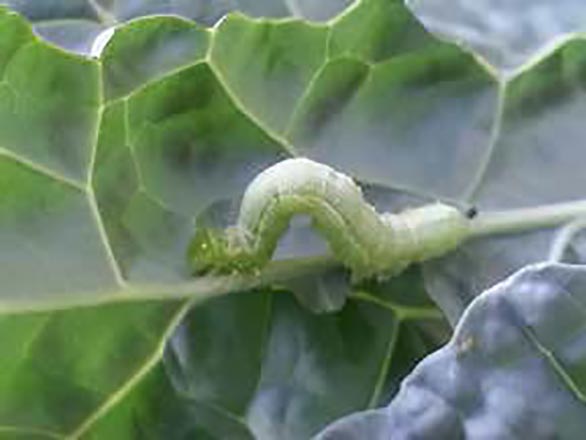 Scientific names: Pieris rapae (cabbage white butterfly), Trichoplusia ni (cabbage looper moth)
Scientific names: Pieris rapae (cabbage white butterfly), Trichoplusia ni (cabbage looper moth)
Order: Lepidoptera
Description: The cabbage white caterpillar is smooth and light green. When fully grown, it is slightly over 1 inch long. The adult butterfly is creamy-white with one or two sets of black dots and black edges on the upper edges of the wings. The cabbage looper caterpillar has thin white stripes along its abdomen and thicker white stripes along the sides. The adult is a spotty light- and dark-brown with a distinct silvery-white spot on the upper side of the wings.
Behavior: Both species eat leaves as caterpillars. They typically hide under leaves or near the base of the plant. Cabbage looper caterpillars lack some pairs of modified legs on the underside of the abdomen, which results in their “inching” movements. Adults fly to search for mates and new host plants. Cabbage white butterfly adults are active during the day, while cabbage looper moths are active at night. Adults of both species drink nectar from flowers.
Life cycle: Both species have similar life cycles. Following egg hatch in mid- to late-spring, the caterpillars go through several stages (or instars), lasting approximately three to four weeks. The caterpillars make silken cocoons (pupal stage) before developing into winged adults. Up to three generations per year are produced. Both the cabbage looper and the cabbage white overwinter in the pupal stage.
Diet and damage: Caterpillars of both species eat plants in the cabbage family, including cabbage, broccoli, cauliflower, kale, Brussels sprouts, collards and many others. Both caterpillars chew large holes from the leaves. Cabbage loopers start feeding on the outsides of the leaves and then move to the head of the plant. Monitoring: Frequent scouting for caterpillars is key to protecting plants. Every few days, look under leaves and stems for small caterpillars, caterpillar excrement and silk webbing.
Control methods:
Cultural: Removing grass or weedy mustards around planted rows can reduce the numbers of nearby individuals. Interplant with nonbrassica crops and mulch around plants to encourage beneficial insects. Mechanical: Regularly hand-pick and destroy small caterpillars. Apply row covers when transplanting seedlings outdoors. Till the garden at the end of the season to kill the overwintering pupal stages of the insects.
Biological: Many insects and other arthropods feed on these caterpillars, including spiders and parasitoid wasps. Look for dead or dying caterpillars with small white silk cocoons attached to their abdomens; these individual caterpillars have been parasitized. Cocoons should be left for adult parasitoid wasps to emerge.
Chemical: There are several organic and synthetic pesticides registered for brassica crops targeting the caterpillar stages of these pests, including insecticidal soaps, oils, pyrethrins, Bacillus thuringiensis var. kurstaki (Bt), Spinosad and several others. Chemical controls are most effective when applied at the early caterpillar stages, as older caterpillars are resistant to several insecticides.
When applying any pesticide, read the entire product label thoroughly before application. If you see a Bee Advisory Box, this newly developed EPA label denotes a potentially high risk to bees and other pollinators.
K. Burls, W. Hanson Mazet, H. Kratsch
2021,
A Northern Nevada Homeowner's Guide to Identifying and Managing Cabbage Caterpillars,
Extension, University of Nevada, Reno, FS-21-109


